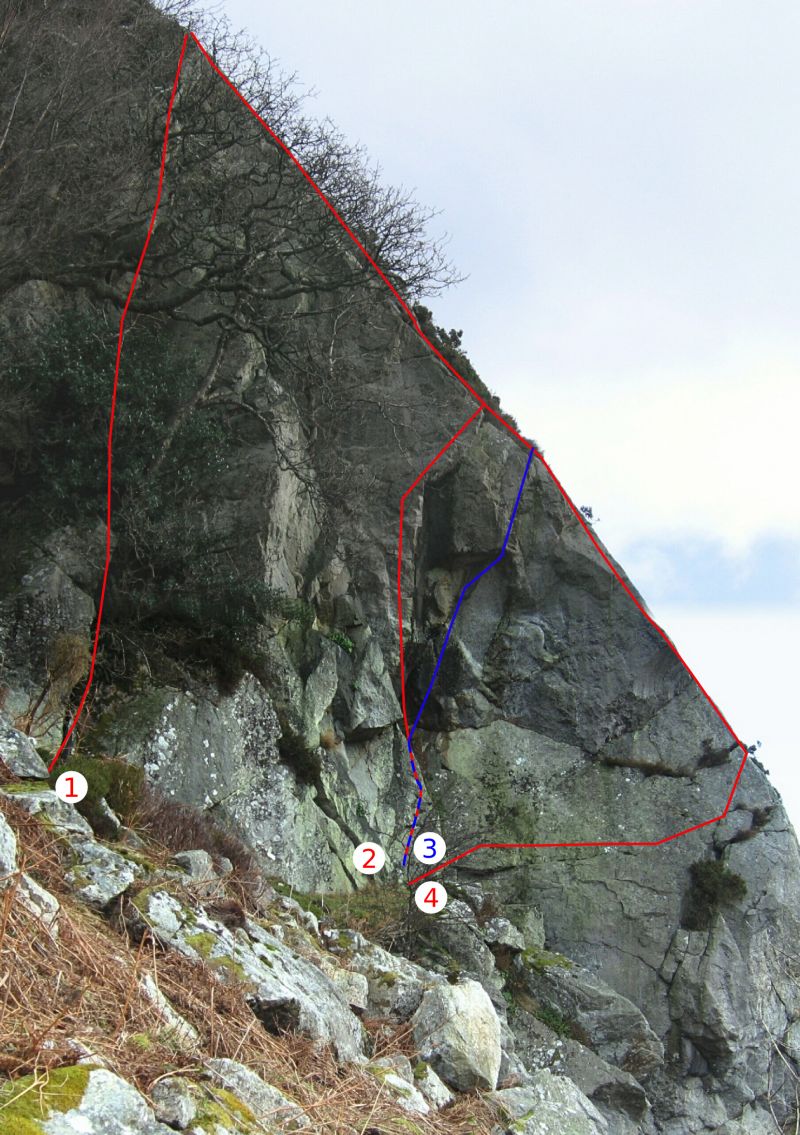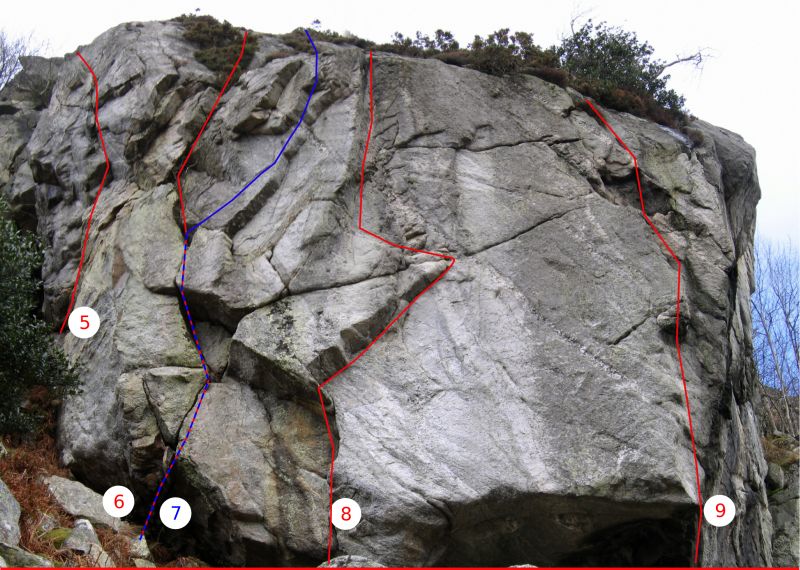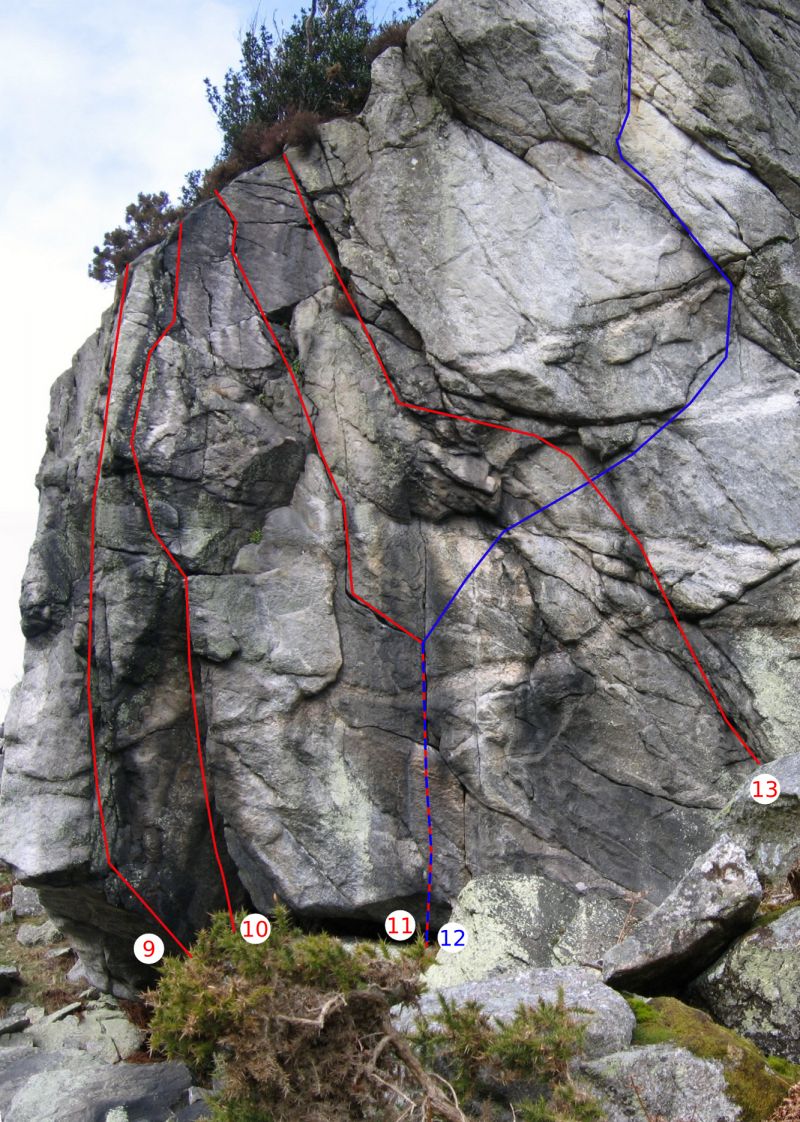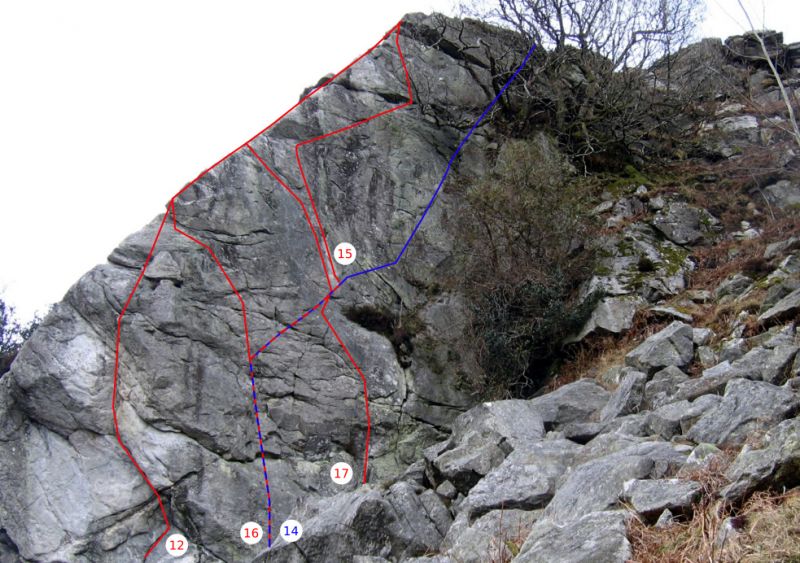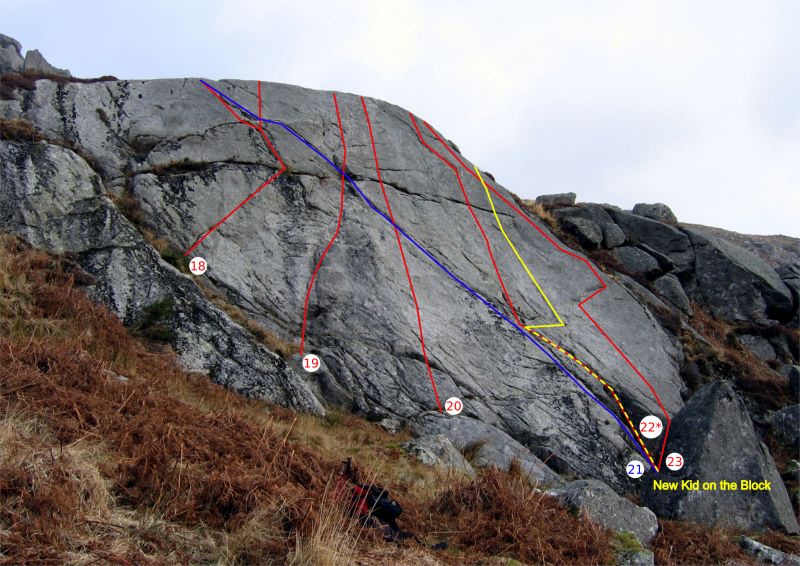Lough Dan
Printed guidebook available here
This small but important climbing area is located at O142 047on the south-facing broken ground of Knocknacloghoge (534m) overlooking the floodplain of the Inchavore River near where it discharges into the northern end of Lough Dan.
The rock is granite, mainly coarse-grained like that of Luggala. The area is essentially a glacially eroded and steepened valley with escarpments further eroded by valleyside gullies. As a result the valley slope is dominated by broken ridges and buttresses, some of which are just about big enough for climbing purposes. The climbing is in a wild and beautiful setting, with splendid views of the meandering Inchavore and the lake itself. Map at bottom of this page
The three possible approaches to the crag are as follows:-
(1) The shortest walk-in was from the south at about 35 – 40 minutes but the shallows where it once was possible to cross the river have been swept away and it in now necessary to go to the grove of oak trees at the western end of the fields and cross at an island there. Follow minor roads from Roundwood via Oldbridge to the Scout Centre at the west side of Lough Dan where it is possible to park on the roadside. Walk to a bridge and sharp road-bend at O 150 031. There may be 2 or 3 parking spaces here but care should be taken to leave room for farm machinery to pass. Residents are less enthusiastic about visitors since one of them had to be brought to hospital by helicopter because it was not possible to get a car past inconsiderately parked visitors' vehicles. Continue for a short distance until a stile on the right gives access to a path across private land which crosses the shoulder of the hill above Lough Dan until the Inchavore floodplain is reached. To ford the river go past a rather large grove of alder (or willow?)trees on its south bank for about 200m until a suitably shallow crossing point is reached. The crag is now 10 minutes away up the hill to the right.
(2) Leave the Military Road at a forest gate at (O 107 055) about 9 km south of Sally Gap on the road to Glenmacnass. Follow the winding forest road in a generally easterly direction until it ends at a forest break. Go left for 100m to the Inchavore River and follow a path eastward along its south bank through an oak grove and to the crossing point mentioned above. This approach takes about one hour.
(3) Park at Luggala Gate Piers (O 172 065). Follow the approach to Luggala crag as far as the crossing of the Cloghoge River (O 162 062) but then continue south down the Cloghoge valley via a road and track. On reaching the lake continue west on a footpath between lake and hill slope until the crag is reached a short distance beyond the lake. This approach will take just over one hour.
Download overview of the area at General view
THE MAIN BUTTRESS
Although climbs have been developed on at least half a dozen outcrops the finest concentration of routes is found on one buttress, a rectangular body of rock projecting out of the hillside. There are oak trees to its left and another large oak and an aspen grove to its right. This buttress has three faces, oriented west, south and east. Most of the climbing on the crag is very steep with a good deal of slightly overhanging rock on the west and south faces. All of these routes had been completed by 1990 and fifteen years later, and probably long into the future, they represent the largest concentration of hard routes on such a relatively small area of rock in Wicklow.
The rock is clean and sound. Although most of the routes are rather short they are also steep and strenuous and some of them call for a sustained level of physical effort. The climbs are recorded from left to right starting with the west face and followed by the south and east faces.
CHUCKLING PIG 20m VS (4b)
This route takes the left-hand side of the west face to the right of trees. It starts 5m right of a holly tree, beneath a steep broken groove with projecting blocks. Climb the groove until it is possible to break right onto a slab below a tree. Move up the slab and past the tree for a few metres towards a corner, exiting right by an overhanging wall.
S.R. Young, D. Walsh, 5/5/1974.
THE CIRCUS ANIMALS' DESERTION ** 12m E3 (5c)
A short but deceptively overhanging groove which will surprise the unfit. Start beneath the overhanging groove to the right of a leftward slanting ramp. Move up the ramp until it is possible to swing into the groove; continue strenuously to the top.
C. O Cofaigh, J. Lyons, 2/9/1990.
EXILES ** 12m E4 (6b)
Start as for Circus Animal's Desertion and go up the groove to the bulge. Step right to the overhanging crack and grapple with this to easier ground above.
H. Hebblethwaite, Summer 1994.
4. HAT TRICK 26m S (4a)
Start just right of The Circus Animals' Desertion on the left side of the slab with a large crack near its right edge. Step up onto the slab and traverse right until it is possible to gain the arête. Ascend the slab above, bearing left and by-passing a heather patch near the slab's left edge before finishing up on better holds.
S.R. Young, D. Walsh, 5/5/1974.
EXCITABLE BOY ** 15m E4 (6a)
Takes the flake crack which splits the bulging wall to the left of Little Oak Crack. Start below an overhanging gully with jammed blocks. Traverse out right on the diagonal crack to a rest-point where this crack joins another crack passing up leftwards through the bulging wall. Climb this by determined lay-backing to bigger finishing holds.
D. O Sullivan, J. Dugdale, 26/8/1990.
LITTLE OAK CRACK ** 15m E1 (5b)
Start about 5m right of Excitable Boy and on the left side of a white wall below an undercut crack with a very small tree. Make a strenuous start to gain the crack and the niche above. Muscle up past a small overhang and the tree to a resting place on the left. Finish up the crack on the right. Well protected.
J. Lyons, D. Wall, 6/8/1989.(First recorded ascent – names of earlier ascensionists uncertain).
LITTLE OAK DIRECT ** 15m E4 (6b)
Takes the upper impending bulge to the right of the normal finish of Little Oak Crack.
R. Browner, Summer 1996.
SURFS UP *** 15m E4 (6a)
Brilliant technical climbing up the hanging groove to the right of Little Oak Crack.
Start 2-3m right of Little Oak Crack below the white wall and just left of a cave. Climb up to a hidden peg runner at a large flat hold. Move out right to a flake and a peg runner. Step back left into the groove and finish strenuously up this. Tree belay on the right.
D. O Sullivan, H. Hebblethwaite, 26/8/1990.
The following five climbs are on the south face of the buttress.
SQUALL * 15m E1 (5b)
Start beneath a hanging groove on the dark south face. From the top of a very large block move leftwards with bold deliberation in an exposed situation onto the arête and strenuously gain the groove above. Follow this more comfortably to the holly tree belay.
T. Burke, J. Stark, 26/8/1990.
JET STREAM * 15m E1 (5b)
Start as for Squall. Climb the hanging groove and the arête above to the finish.
J. Price, H. Hebblethwaite, 1985.
LIGHTNING CRACK ** 15m E2 (5c)
Starts 2m right of Squall on the block ledge below a zig-zag finger crack. Follow the strenuous crack slightly leftwards until better holds around a small sloping ledge are reached. Finish up the short cracks leftwards to the arête and the tree belay.
H. Hebblethwaite, J. Price, 1985.
ARCHAOS *** 18m E6 (6b)
This route boasts the steepest climbing in Wicklow with well protected cranking on perfect granite. Start as for Lightning Crack. Follow Lightning Crack for 2m to a letterbox jug. Move a little to the right before pushing on up to a good rest and a peg-runner shared with Storm Cloud in the horizontal black fault-line undercutting the white rock above. Traverse right for a metre to a good side-pull and then make a tricky move to gain the base of an overhanging groove. Climb this (crux) past a peg runner to an even steeper finish in a wild position. Move down and left to belay at the tree or finish directly up the slab.
D. O Sullivan, J. Dugdale, (Redpoint ascent) 31/8/1990.
STORM CLOUD ** 16m E3 (6a)
Takes the flake fault-line diagonally leftwards across the wall. Start a few metres right of Lightning Crack and follow the fault-line past a peg-runner to another peg-runner in the horizontal undercut (shared with Archaos). Go past a slight bulge and finish up the wide left-slanting crack just right of the finish of Lightning Cracks. Belay at the holly tree.
T. Burke, 27/8/1990.
The next group of climbs are found on the more featureless but less steep east face. The climbing is not as strenuous but is quite thin and delicate in places and requires some careful route-finding.
SIDEWINDER ** 35m E1 (5b/c)
Essentially a rising traverse climbing the east face from bottom left to top right. Start on a grassy patch on the lowest point of the face.Climb the centre of the wall to a horizontal crack at about 5m. From here take a slightly rising line rightwards (crux) to a long white streak just above a small turf ledge. Continue rightwards to a large hidden stance and follow a right-trending crack before going straight up, passing tree branches with dexterity.
D. O Sullivan, J. Armstrong, October 1984.
DECEPTION ** 30m E2 (5c)
An excellent wall climb which starts as for Sidewinder. Follow Sidewinder to the horizontal break and then diagonally right to the base of the obvious long white streak rising from the turf ledge. Follow the streak straight up to an undercut horizontal joint just below the arête. Traverse right for 6m to a large hidden ledge in the centre of the wall. From the middle of the ledge follow a crack to a good flake hold. From here trend left to a good stance on the arête
left of a small black overlap.
D. O Sullivan, J. Armstrong, October 1984.
DUPLICITY * 35m E2 (5c, 4a)
The crux is short but demanding nonetheless.
1. 20m Start as for Sidewinder which is followed to the horizontal crack. Continue straight up to undercut horizontal joints which intersect the arête. Move out left onto the arête at this point and follow it for about 6 - 7m to a good belay.
2. 15m Continue up to the top in a pleasant situation near the right-hand edge.
T. Burke, J. Lyons, 26/8/1990.
TOMAHAWK * 35m E1 (5b, 4a)
Starts just right of Sidewinder at a short corner. 1. 20m Climb up slightly right to below the peaty ledge and then work out left and up past a bulge on thin holds (crux). Move back right and follow the white streak to just below the small overhang and an obvious lead out left to an arête. Belay a metre or so up the arête. 2. 15m Continue up the right edge of the slab to the top.
J. Lyons, C. O Cofaigh, 2/9/1990.
OTHER BUTTRESSES
A number of other buttresses are scattered along the hillside to the west and east of the Main Buttress. These are described from west to east, starting with the only buttress to the west.
This is a steep triangular slab on the edge of the flood-plain, directly behind the ruins of a long-abandoned farmstead and about 500m west of the Main Buttress. The rock is clean and sound. Descent is easy via a ramp to the side of the slab. Ring bolts, useful for belaying, were installed on top of the buttress but have since been hammered flat
DRAGONFLY 15m VS (4c)
Takes the diagonal crack leading up right to the horizontal break line. Climb the crack and slab to the break and finish by either the crack leading up to the left or directly up the final slab.
J. Lyons, D. Wall, 18/7/2004.
HEATHER BEE 15m HS (4b)
Follow the quartz edge sloping up right to the edge of the slab. Alternatively start 1 - 2m further right and climb directly to the mid-height ledge.
J. Lyons, 22/5/1994.
OASIS 17m HS (4b)
Takes a direct line up the centre of the slab, starting several metres right of the quartz edge and finishing just right of same.
J. Lyons, 22/5/1994.
BLUEBELL FAREWELL 22m S (4a)
A rising traverse starting just left of the niche and following a crack-line diagonally left across the face. Near the top step up onto the slab above the crack and finish directly.
J. Lyons, D. Wall, 18/7/2004 (first recorded ascent).
DENIZENS OF OLD 18m VS (4c)
Starts at a niche on the right-hand side of the slab. Climb leftwards out of the niche onto the slab and up to the two parallel quartz seams. Follow the left-hand one to a bulge and gain a slanting crack above below the final edge; up this to finish.
J. Lyons, 8/3/1992.
NEW KID ON THE BLOCK" 18m HVS(5a)
Start as for Denizens of Old up to base of the two parallel quartz seams (moving up Bluebell Farewell makes it possible to place side runners before returning to this point). Tiptoe up by the right-hand seam to reach a horizontal break. Stand comfortably on this before launching up the featureless slab and arete to the top.
G. Galligan, S. O Hanlon 9/7/2017
DANCING WITH EXCITEMENT * 20m HVS (5a)
Gain a small foot-ledge right of the niche and move diagonally up left via a slanting edge to the right-hand quartz seam. Work out right along an edge-line to the arête (crux). Finish up the arête.
J. Lyons, D. Wall, 18/7/2004.
About 50m to the right or east of the Main Buttress and just above a copse there is a large, partly vegetated broken buttress area, the left flank of which has yielded some routes. The next two climbs are found on the bottom left side of this buttress, directly opposite the Main Buttress and just above the copse.
SKEDADDLE 14m HS (4b)
Start on a ledge below an obvious ramp on the left side of the overhanging outcrop. Climb the ramp and pass blocks carefully to reach an overhanging corner which is surmounted (crux) to finish.
J. Lyons, T. Groves, November 1988.
DOGPATCH * 21m VS (4a,4c)
1. 13m Start 2m right of Skedaddle on a ledge by a holly bush. Gain the large V-shaped notch, move left and exit onto the large ledge via cracks and flakes.
2. 8m Use large handholds to surmount the roof near its left side.
J. Lyons, 28/5/1989.
The following route is found on a small rock face just right of the Main Buttress and to the left of the copse.
UPWARDLY MOBILE * 10m E1 (5c)
Takes a central line on the face and has the character of an extended boulder problem and is harder than it looks. Climb the thin crack in the steep slab directly to the ledge. Move slightly right and surmount the short wall
J. Lyons, 1/2004/1990.
Further up the gully there are some climbs on a holly-clad buttress which are described from right to left.
SAFE HAVEN 30m HVS (5a, 4b)
Starts about 40m up the gully from Skeddadle below a narrow, left-edged slab. 1. 10m Climb the slab boldly to a furze ledge below the steep holly buttress. 2. 18m Gain a short wall on the left, moving up right to a ledge; up a quartz-rich wall to a stance and surmount a tricky wall above to finish.
J. Lyons, D. Wall, 5/9/1998.
HEAVEN CAN WAIT * 18m VS (4c)
Start below a leftward slanting, bow-shaped crack and climb to a stance. Finish up the slabby wall behind the trees.
J. Lyons, D. Wall, 5/9/1999.
SHADOWLAND 18m VS (4c)
Start below a right-facing corner. Climb up and traverse right at the top to a stance. Move left behind the trees and take a short, wide crack followed by an awkward step to finish. Thread belay well back.
J. Lyons, D. Wall, 20/9/1998.
LOOK OUT 18m VS (4c)
Start below a short wall just left of the corner of Shadowland. Climb the short wall to the right of the thin crack-line, with the help of holds on the arête, to the holly tree. Continue up by a holly tree on the left passing a projecting block to below a slight overhang. Surmount this by moving up left before exiting to the right of the large boulder.
J. Lyons, D. Wall, 31/10/1998.
The next area of climbing interest is found alongside a large shallow gully about 200m to the right or east of the Main Buttress. There are two routes on a triangular buttress right of the gully.
AVALON DREAM ** 20m HVS (4c)
An enjoyable route which essentially follows the arête on the left-hand side of the buttress. Start below a short green niche, right of the gully. Gain the groove and follow the left-trending crack above it for some distance before gaining the steep slab on the right. Follow the left edge of the slab to the top.
J. Lyons, D. Wall, 6/8/1989.
A COLD WINTER'S DAY 25m VS (4c)
Start right of the gully below a short wall with a righttrending crack. Climb the crack with an awkward exit right onto a wide ledge (possible belay). Continue up the wall above to a small niche; gain height to a sloping heathery ledge and up on good holds towards the arête on the right which is gained near its highest point for the best finish.
J. Lyons, T. Groves, November 1988.
About 10m up from the start of Avalon Dream past a heathery rake there is a steep narrow face where the next route is found.
HONEY BEE 12m HS (4b)
Climb the face for about 5m to its right-hand edge and follow the edge past some blocks at the top to finish.
J. Lyons, 22/5/1994.
Some 50m up and left of the gully from the Avalon Dream buttress there is a broken, overhanging buttress on which there are two climbs.
TURNING POINT 20m HVS (5a)
Start at a niche on the front right of the buttress. Up right onto a ledge below a roof. Move out precariously onto an exposed edge and then up to become established in a wide crack. Continue up directly, passing to the left of the roof before gaining easier ground.
J. Lyons, D. Wall, 18/7/2004.
EMBOLDENED 15m VS (4c)
Start on the right-hand side of the buttress at a rock pillar. Climb the pillar and with difficulty gain a slabby corner above the overhang. Move up and out right to gain a short groove. Climb past the roof on its right side to finish.
J. Lyons, D. Wall, 5/9/1999.
A little further to the right along the hillside there is a prominent broken rock ridge with a brown-coloured slab at its base and a projecting rock nose near the top. The following route takes a line up this ridge.
PROW BUTTRESS RIDGE 125m VS (4c, 4b, 4c, 4b)
Although somewhat disjointed the route offers a series of interesting problems and a perhaps unexpected sense of exposure near the top. Start at the brown slab at the bottom left of the ill-defined ridge.
1. 15m From the centre of the slab move up diagonally left past a series of horizontal breaks to the top left of the slab.
2. 30m Move right over grassy ground to the base of the ridge proper. Climb a slab towards some projecting blocks and pull past these before scrambling to a belay at a rowan tree.
3. 35m Move up a short steep slab behind the tree and then an easy-angled slab to a short chimney corner. Up this with difficulty and continue on for 10-15m to a block belay.
4. 45m Continue up the steepening slab, traversing out below the rock nose to a short overhanging corner with a jammed block. Climb this with an awkward exit and continue up a short wide crack to the right of a large block, finishing directly to the top.
J. Lyons, D. Wall, 14/6/2004.
Four routes start on the Prow at the top of the previous route. The difficulties are rather short-lived but the rock is clean and there are some exciting moments.
SHOOTING STAR 12m HS (4b)
Start to the left of the Prow at a steep corner. Climb this and the easier ground above it.
J. Lyons, D. Wall, 3/9/2000.
FALLEN ANGELS 15m HS (4b)
Start to the right of the corner, moving out right below the roof to gain a ledge. Finish up the cleft.
J. Lyons, D. Wall, 3/9/2000.
THE MILKY WAY 15m VS (5a)
Follow the quartz vein to the ledge and up the arête on the left.
J. Lyons, D. Wall, 3/9/2000.
BLUE HEAVEN * 20m HVS (5b)
Start at the quartz vein but move out right in a precarious situation to gain an obvious slanting edge and thence reach the ledge above. Move back left and finish up to the right of the arête.
J. Lyons, D. Wall, 3/9/2000.
